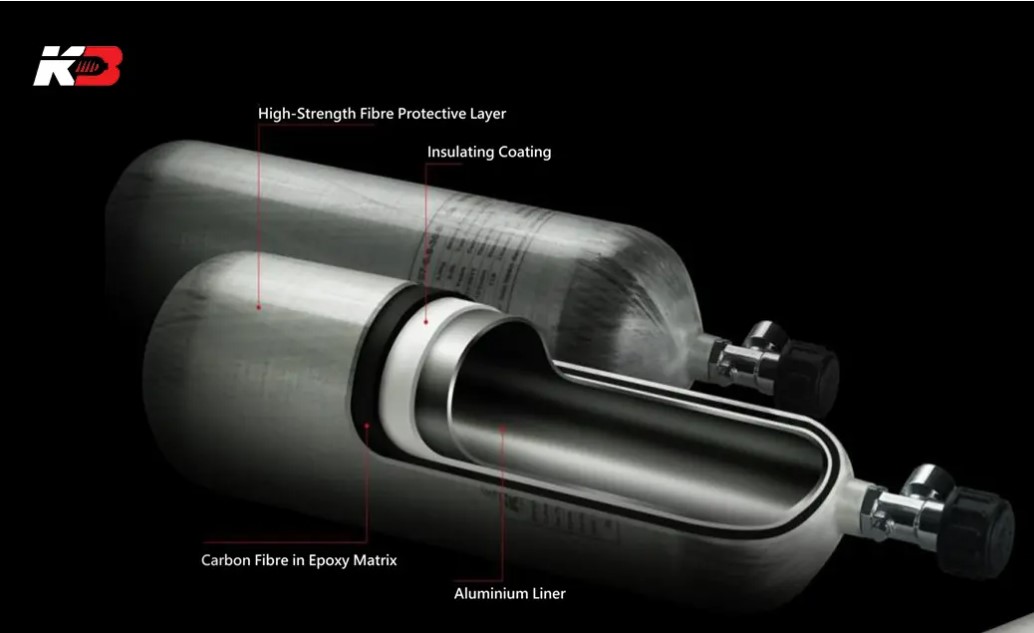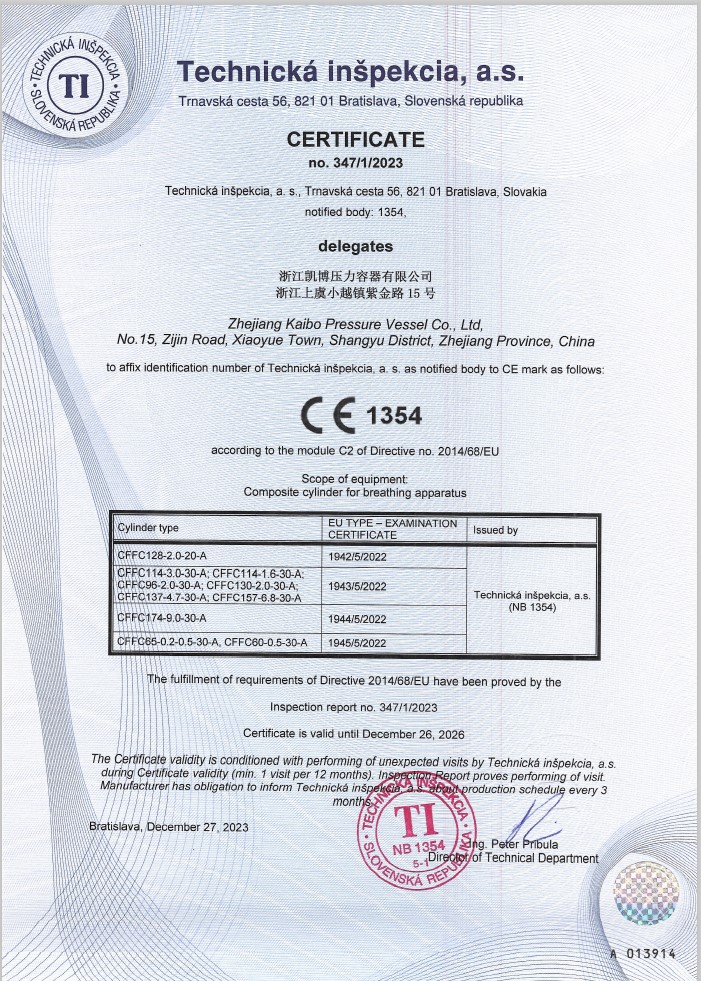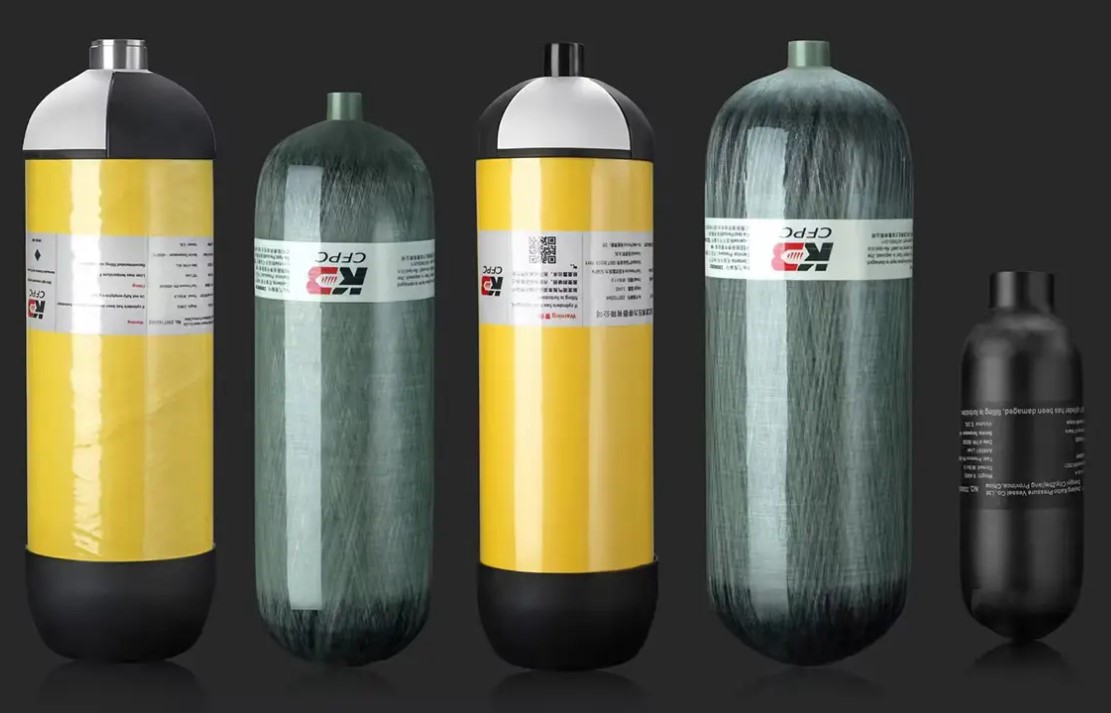Introduction
Self-contained breathing apparatus (SCBA) units are critical safety tools used by firefighters, emergency responders, industrial workers, and others who operate in environments with poor or dangerous air quality. A key component of SCBA units is the air cylinder. Traditionally, steel cylinders have been used, but in recent years, carbon fiber composite cylinders have become the preferred choice in many fields. This article takes a closer look at why carbon fiber cylinders are widely adopted, focusing on their structure, performance, and advantages in the context of lightweight SCBA systems.
1. Structure of Carbon Fiber Composite Cylinders
Carbon fiber cylinders are not made from carbon fiber alone. They usually consist of a lightweight aluminum liner wrapped with layers of carbon fiber and sometimes glass fiber or aramid fiber. These fibers are embedded in a resin matrix to form a high-strength composite.
- Aluminum liner: Provides an airtight barrier for gas containment.
- Carbon fiber wrap: Delivers high strength with low weight.
- Resin system: Holds the fibers in place and provides durability.
This layered construction allows the cylinder to withstand high pressures while remaining much lighter than solid metal alternatives.
2. Key Benefits in SCBA Applications
a. Weight Reduction
The most noticeable advantage of carbon fiber cylinders is their lighter weight. On average, a carbon fiber SCBA cylinder can weigh about 30% to 50% less than a comparable steel one. This is especially important for firefighters and rescue workers who carry SCBA units during physically demanding tasks.
- Lighter equipment reduces fatigue.
- Greater mobility in confined or elevated spaces.
- Easier to wear for extended periods.
b. Higher Working Pressure
Carbon fiber cylinders can often operate at higher working pressures, commonly 300 bar (4350 psi), compared to traditional steel cylinders, which may be limited to 200 or 221 bar.
- Higher pressure means more air stored in the same size tank.
- Extends working time in hazardous areas without needing larger cylinders.
c. Corrosion Resistance
Unlike steel, carbon fiber composite materials do not rust. The aluminum liner may be subject to some internal corrosion if moisture enters, but the outer composite shell resists environmental corrosion very well.
- More durable in humid or marine conditions.
- Longer life span with less maintenance related to rust.
3. Enhanced Safety and Ergonomics
Modern SCBA units with carbon fiber tanks are designed to be ergonomic and safer in challenging environments.
- Balanced weight distribution on the back.
- Reduced strain on shoulders and spine.
- Lower chance of slipping or imbalance during motion.
Also, the structural integrity of carbon fiber cylinders is rigorously tested. They must pass impact, drop, and pressure burst tests to meet international safety standards like DOT or ISO.
4. Regulatory Compliance and Certifications
Carbon fiber SCBA cylinders are certified by several regulatory bodies depending on their intended market:
- DOT (U.S. Department of Transportation)
- ISO (International Organization for Standardization)
- CE (European Conformity)
These standards ensure that the cylinder can handle the required pressure and operating conditions without failure.
5. Maintenance and Handling Practices
Even though carbon fiber cylinders are durable, they still require regular inspection and care:
- Visual inspection before each use: Look for cracks, dents, or fiber exposure.
- Hydrostatic testing: Typically every 3 or 5 years depending on regulations.
- Avoid chemical exposure: Some solvents can damage the resin system.
- Proper storage: Avoid extreme heat and sunlight to prevent resin degradation.
Following these basic practices helps preserve the performance and safety of the cylinder.
6. Cost vs. Value Considerations
Carbon fiber cylinders are more expensive upfront than steel cylinders. However, the added cost is offset by their advantages:
- Reduced injury risk due to lower carried weight.
- Longer operating time per fill.
- Lower long-term maintenance cost.
- Higher overall productivity and user comfort.
For departments and organizations that prioritize safety, performance, and efficiency, the value of carbon fiber cylinders is usually well justified.
Conclusion
Carbon fiber composite cylinders have become a crucial component in modern SCBA units. Their lightweight nature, high-pressure capacity, corrosion resistance, and improved ergonomics offer clear benefits over traditional steel tanks. While they do require proper handling and periodic maintenance, their contribution to worker safety and performance in critical environments is significant. As material technology continues to evolve, carbon fiber cylinders will likely remain at the forefront of breathing safety equipment.
Post time: May-22-2025



